Research Project: Employee Satisfaction in Sheraton Hotel Workplace
VerifiedAdded on 2021/06/01
|46
|13848
|109
Report
AI Summary
This research project, conducted by Tran Khanh Linh, examines employee satisfaction at the Sheraton Hotel & Resort. The study investigates the influence of various factors, including the working environment, benefits, relationships, promotion opportunities, and job descriptions, on employee satisfaction levels. The report includes a literature review of relevant theories, a detailed methodology outlining the survey design and data analysis techniques, and a presentation of the research findings. Data analysis involves reliability testing, Exploratory Factor Analysis (EFA), econometric modeling, and hypothesis testing. The research aims to identify the key determinants of employee satisfaction and provide recommendations for the hotel to enhance employee morale and productivity. The report also explores demographic factors and their impact on employee satisfaction and benefits. The research uses Data Analysis, Regression Analysis, and Descriptive Statistics to test theories and provide insights into the workplace dynamics within the hotel. The report concludes with the findings, conclusions, and recommendations for improving employee satisfaction within the Sheraton Hotel & Resort.
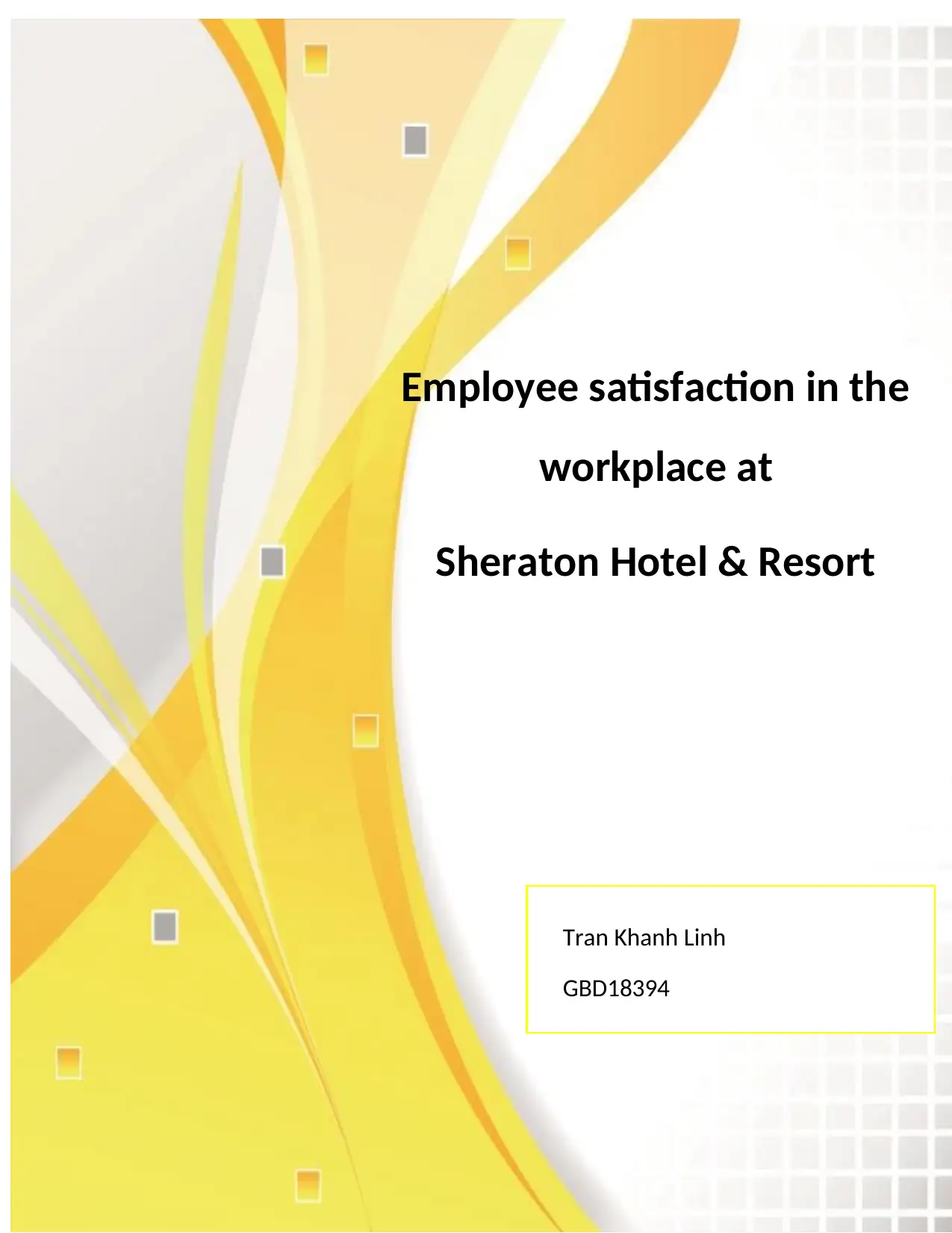
Employee satisfaction in the
workplace at
Sheraton Hotel & Resort
Tran Khanh Linh
GBD18394
workplace at
Sheraton Hotel & Resort
Tran Khanh Linh
GBD18394
Paraphrase This Document
Need a fresh take? Get an instant paraphrase of this document with our AI Paraphraser
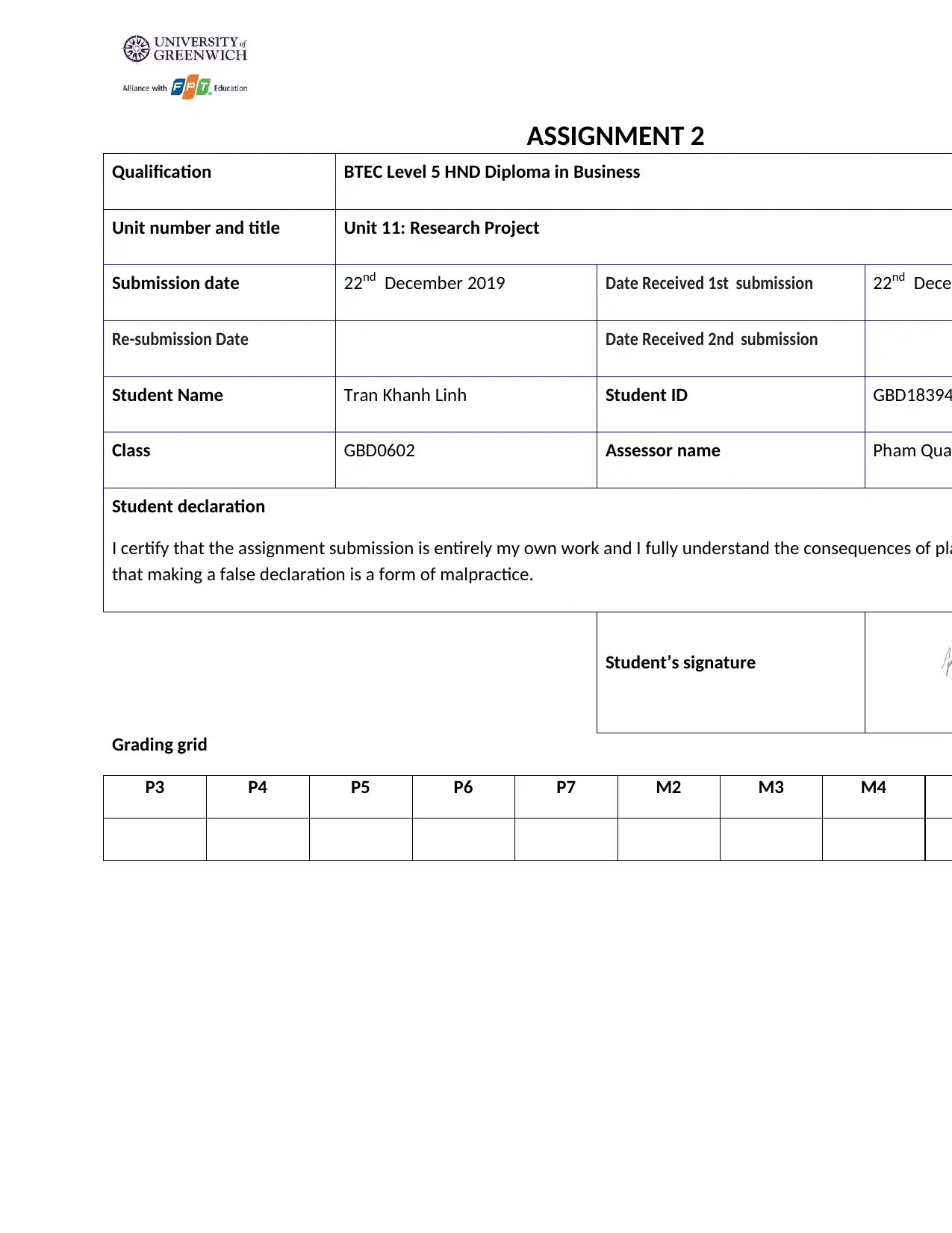
ASSIGNMENT 2
Qualification BTEC Level 5 HND Diploma in Business
Unit number and title Unit 11: Research Project
Submission date 22nd December 2019 Date Received 1st submission 22nd Decem
Re-submission Date Date Received 2nd submission
Student Name Tran Khanh Linh Student ID GBD18394
Class GBD0602 Assessor name Pham Qua
Student declaration
I certify that the assignment submission is entirely my own work and I fully understand the consequences of pla
that making a false declaration is a form of malpractice.
Student’s signature
Grading grid
P3 P4 P5 P6 P7 M2 M3 M4
Qualification BTEC Level 5 HND Diploma in Business
Unit number and title Unit 11: Research Project
Submission date 22nd December 2019 Date Received 1st submission 22nd Decem
Re-submission Date Date Received 2nd submission
Student Name Tran Khanh Linh Student ID GBD18394
Class GBD0602 Assessor name Pham Qua
Student declaration
I certify that the assignment submission is entirely my own work and I fully understand the consequences of pla
that making a false declaration is a form of malpractice.
Student’s signature
Grading grid
P3 P4 P5 P6 P7 M2 M3 M4
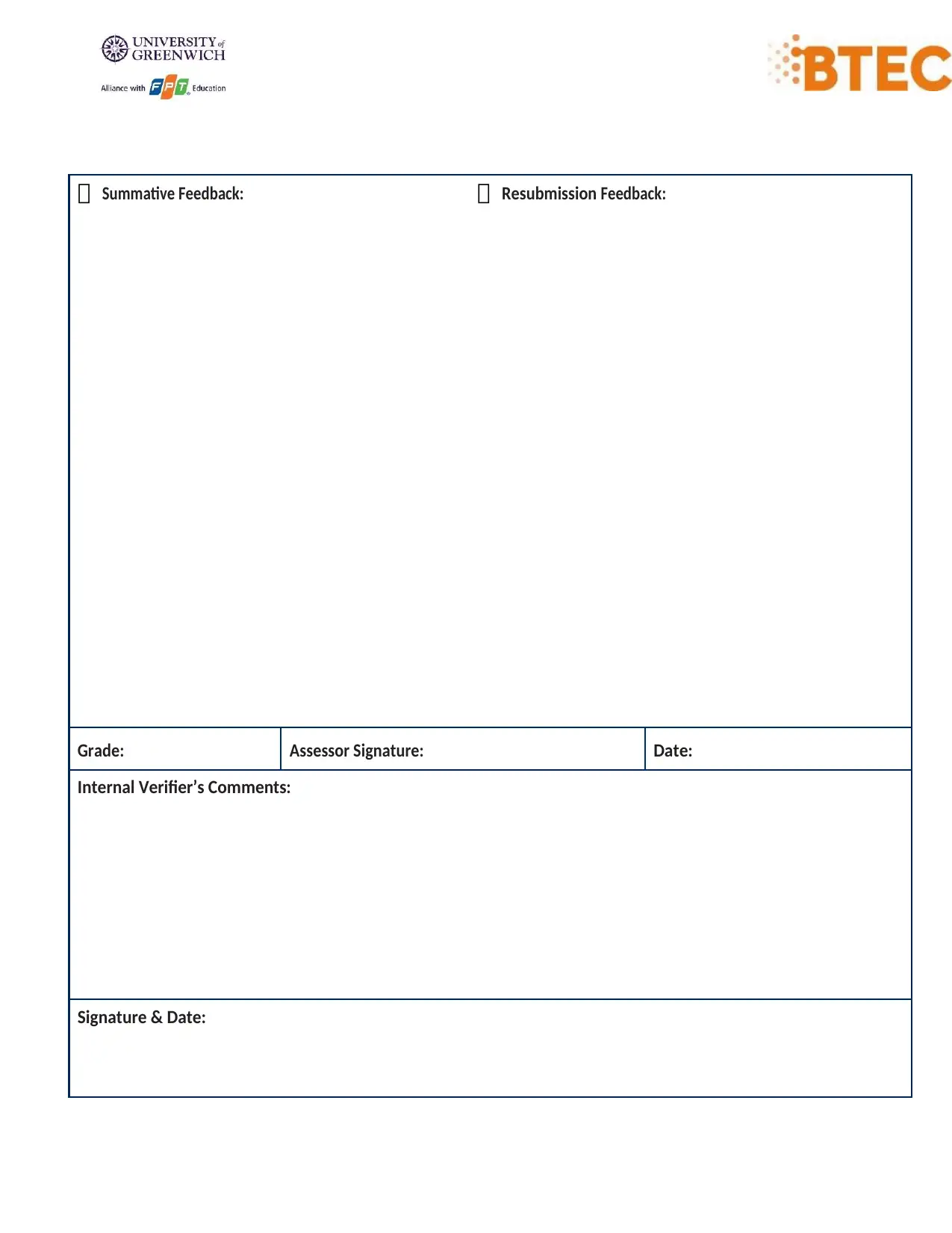
Summative Feedback: Resubmission Feedback:
Grade: Assessor Signature: Date:
Internal Verifier’s Comments:
Signature & Date:
Grade: Assessor Signature: Date:
Internal Verifier’s Comments:
Signature & Date:
⊘ This is a preview!⊘
Do you want full access?
Subscribe today to unlock all pages.

Trusted by 1+ million students worldwide
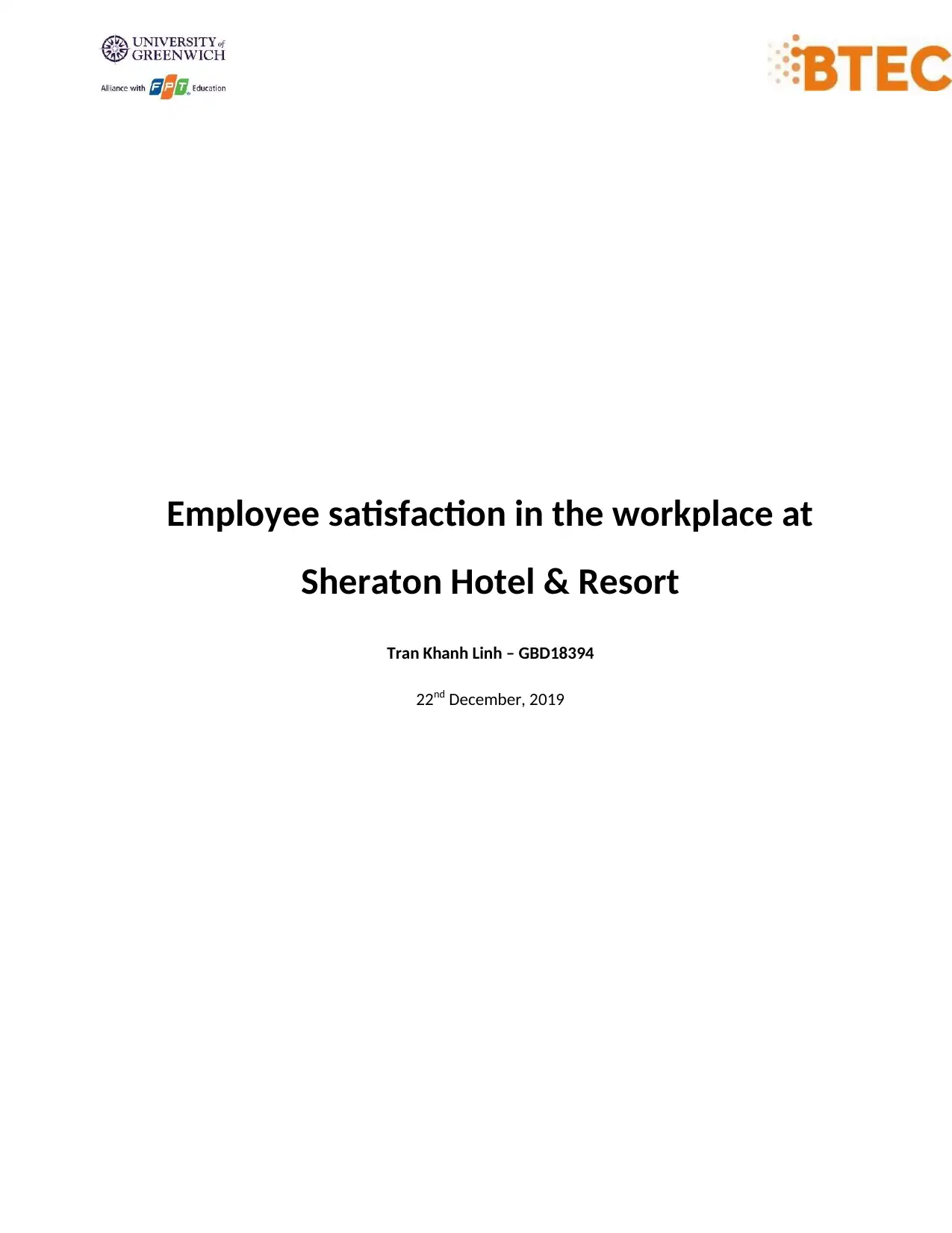
Employee satisfaction in the workplace at
Sheraton Hotel & Resort
Tran Khanh Linh – GBD18394
22nd December, 2019
Sheraton Hotel & Resort
Tran Khanh Linh – GBD18394
22nd December, 2019
Paraphrase This Document
Need a fresh take? Get an instant paraphrase of this document with our AI Paraphraser
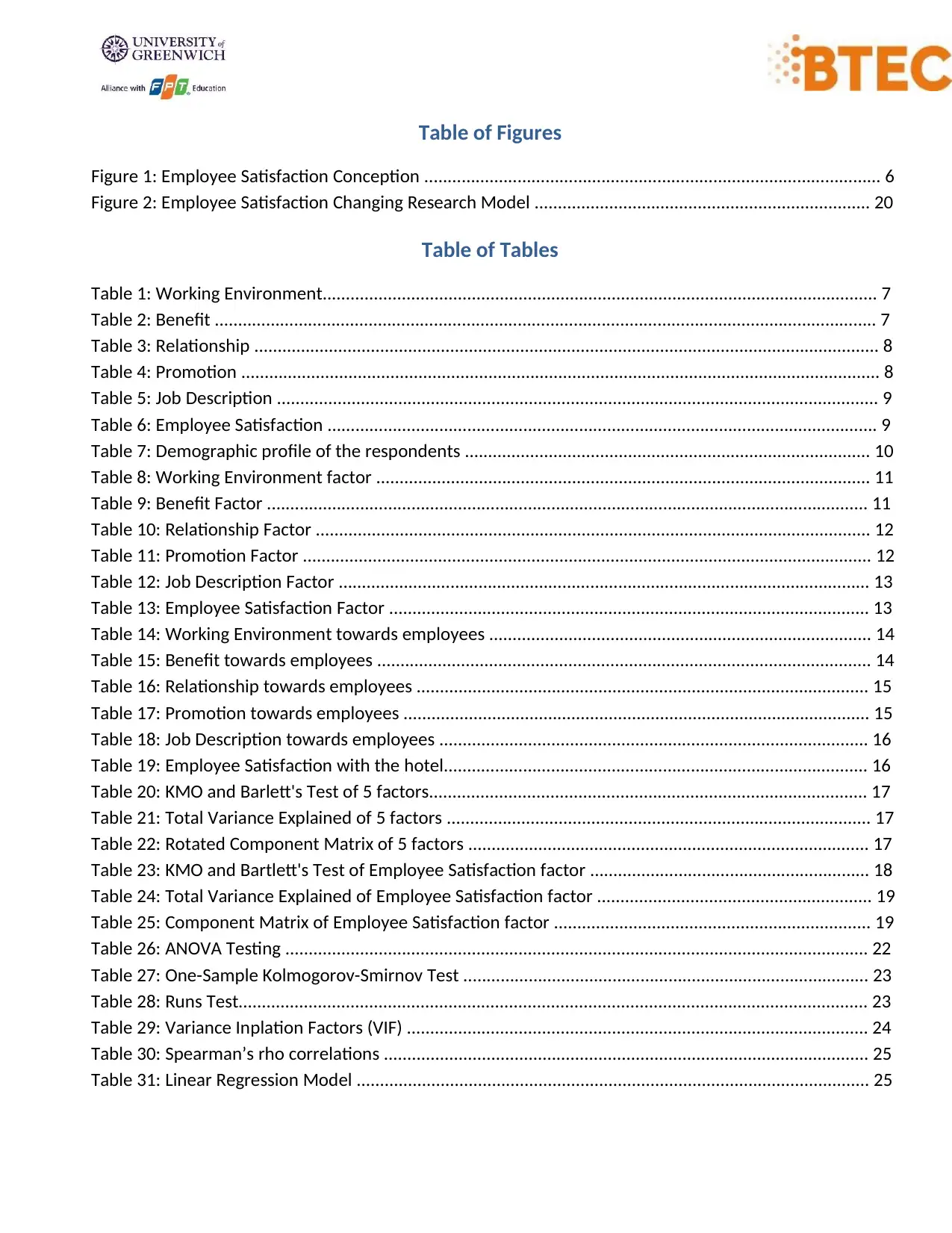
Table of Figures
Figure 1: Employee Satisfaction Conception .................................................................................................. 6
Figure 2: Employee Satisfaction Changing Research Model ........................................................................ 20
Table of Tables
Table 1: Working Environment....................................................................................................................... 7
Table 2: Benefit .............................................................................................................................................. 7
Table 3: Relationship ...................................................................................................................................... 8
Table 4: Promotion ......................................................................................................................................... 8
Table 5: Job Description ................................................................................................................................. 9
Table 6: Employee Satisfaction ...................................................................................................................... 9
Table 7: Demographic profile of the respondents ....................................................................................... 10
Table 8: Working Environment factor .......................................................................................................... 11
Table 9: Benefit Factor ................................................................................................................................. 11
Table 10: Relationship Factor ....................................................................................................................... 12
Table 11: Promotion Factor .......................................................................................................................... 12
Table 12: Job Description Factor .................................................................................................................. 13
Table 13: Employee Satisfaction Factor ....................................................................................................... 13
Table 14: Working Environment towards employees .................................................................................. 14
Table 15: Benefit towards employees .......................................................................................................... 14
Table 16: Relationship towards employees ................................................................................................. 15
Table 17: Promotion towards employees .................................................................................................... 15
Table 18: Job Description towards employees ............................................................................................ 16
Table 19: Employee Satisfaction with the hotel........................................................................................... 16
Table 20: KMO and Barlett's Test of 5 factors.............................................................................................. 17
Table 21: Total Variance Explained of 5 factors ........................................................................................... 17
Table 22: Rotated Component Matrix of 5 factors ...................................................................................... 17
Table 23: KMO and Bartlett's Test of Employee Satisfaction factor ............................................................ 18
Table 24: Total Variance Explained of Employee Satisfaction factor ........................................................... 19
Table 25: Component Matrix of Employee Satisfaction factor .................................................................... 19
Table 26: ANOVA Testing ............................................................................................................................. 22
Table 27: One-Sample Kolmogorov-Smirnov Test ....................................................................................... 23
Table 28: Runs Test....................................................................................................................................... 23
Table 29: Variance Inplation Factors (VIF) ................................................................................................... 24
Table 30: Spearman’s rho correlations ........................................................................................................ 25
Table 31: Linear Regression Model .............................................................................................................. 25
Figure 1: Employee Satisfaction Conception .................................................................................................. 6
Figure 2: Employee Satisfaction Changing Research Model ........................................................................ 20
Table of Tables
Table 1: Working Environment....................................................................................................................... 7
Table 2: Benefit .............................................................................................................................................. 7
Table 3: Relationship ...................................................................................................................................... 8
Table 4: Promotion ......................................................................................................................................... 8
Table 5: Job Description ................................................................................................................................. 9
Table 6: Employee Satisfaction ...................................................................................................................... 9
Table 7: Demographic profile of the respondents ....................................................................................... 10
Table 8: Working Environment factor .......................................................................................................... 11
Table 9: Benefit Factor ................................................................................................................................. 11
Table 10: Relationship Factor ....................................................................................................................... 12
Table 11: Promotion Factor .......................................................................................................................... 12
Table 12: Job Description Factor .................................................................................................................. 13
Table 13: Employee Satisfaction Factor ....................................................................................................... 13
Table 14: Working Environment towards employees .................................................................................. 14
Table 15: Benefit towards employees .......................................................................................................... 14
Table 16: Relationship towards employees ................................................................................................. 15
Table 17: Promotion towards employees .................................................................................................... 15
Table 18: Job Description towards employees ............................................................................................ 16
Table 19: Employee Satisfaction with the hotel........................................................................................... 16
Table 20: KMO and Barlett's Test of 5 factors.............................................................................................. 17
Table 21: Total Variance Explained of 5 factors ........................................................................................... 17
Table 22: Rotated Component Matrix of 5 factors ...................................................................................... 17
Table 23: KMO and Bartlett's Test of Employee Satisfaction factor ............................................................ 18
Table 24: Total Variance Explained of Employee Satisfaction factor ........................................................... 19
Table 25: Component Matrix of Employee Satisfaction factor .................................................................... 19
Table 26: ANOVA Testing ............................................................................................................................. 22
Table 27: One-Sample Kolmogorov-Smirnov Test ....................................................................................... 23
Table 28: Runs Test....................................................................................................................................... 23
Table 29: Variance Inplation Factors (VIF) ................................................................................................... 24
Table 30: Spearman’s rho correlations ........................................................................................................ 25
Table 31: Linear Regression Model .............................................................................................................. 25
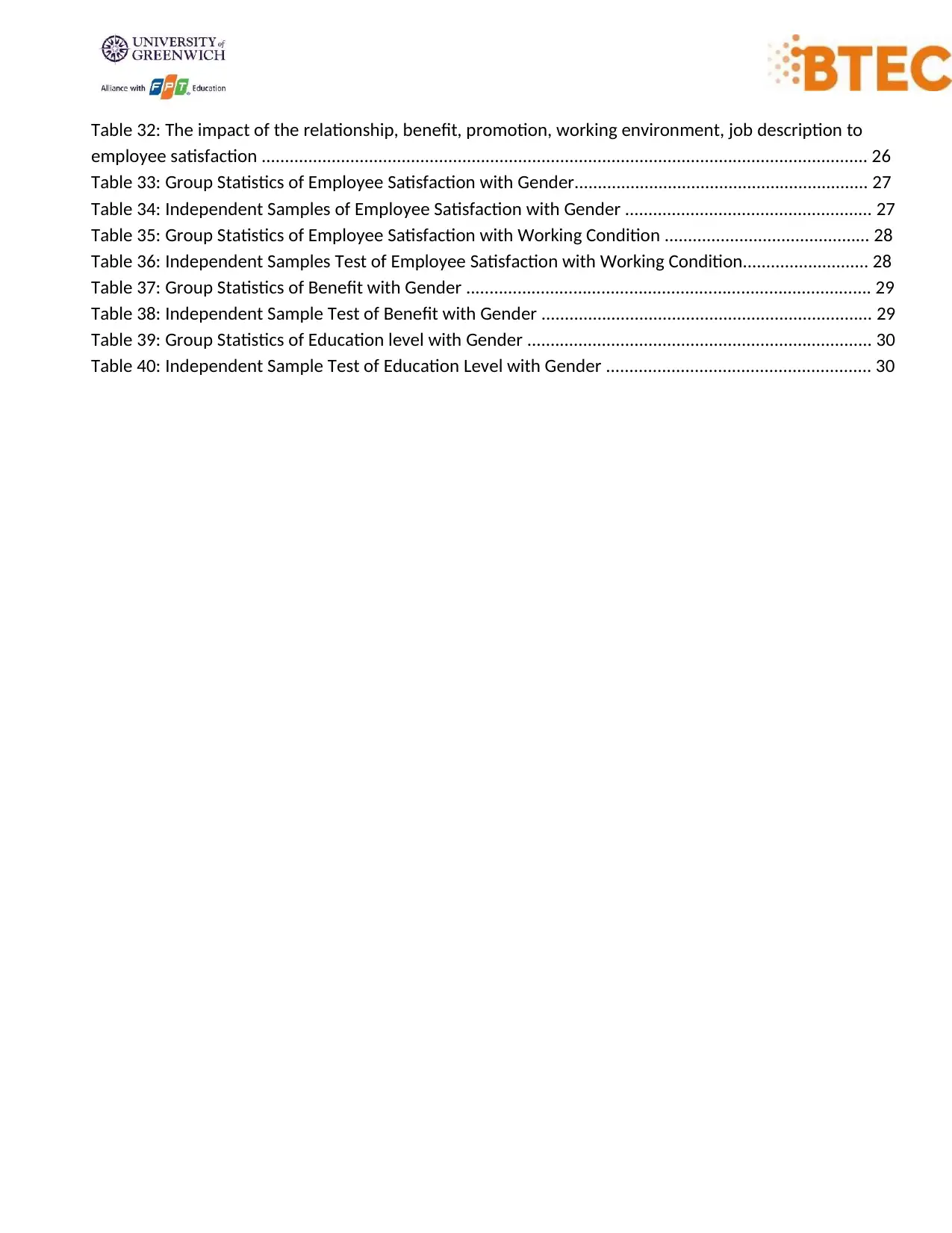
Table 32: The impact of the relationship, benefit, promotion, working environment, job description to
employee satisfaction .................................................................................................................................. 26
Table 33: Group Statistics of Employee Satisfaction with Gender............................................................... 27
Table 34: Independent Samples of Employee Satisfaction with Gender ..................................................... 27
Table 35: Group Statistics of Employee Satisfaction with Working Condition ............................................ 28
Table 36: Independent Samples Test of Employee Satisfaction with Working Condition........................... 28
Table 37: Group Statistics of Benefit with Gender ....................................................................................... 29
Table 38: Independent Sample Test of Benefit with Gender ....................................................................... 29
Table 39: Group Statistics of Education level with Gender .......................................................................... 30
Table 40: Independent Sample Test of Education Level with Gender ......................................................... 30
employee satisfaction .................................................................................................................................. 26
Table 33: Group Statistics of Employee Satisfaction with Gender............................................................... 27
Table 34: Independent Samples of Employee Satisfaction with Gender ..................................................... 27
Table 35: Group Statistics of Employee Satisfaction with Working Condition ............................................ 28
Table 36: Independent Samples Test of Employee Satisfaction with Working Condition........................... 28
Table 37: Group Statistics of Benefit with Gender ....................................................................................... 29
Table 38: Independent Sample Test of Benefit with Gender ....................................................................... 29
Table 39: Group Statistics of Education level with Gender .......................................................................... 30
Table 40: Independent Sample Test of Education Level with Gender ......................................................... 30
⊘ This is a preview!⊘
Do you want full access?
Subscribe today to unlock all pages.

Trusted by 1+ million students worldwide
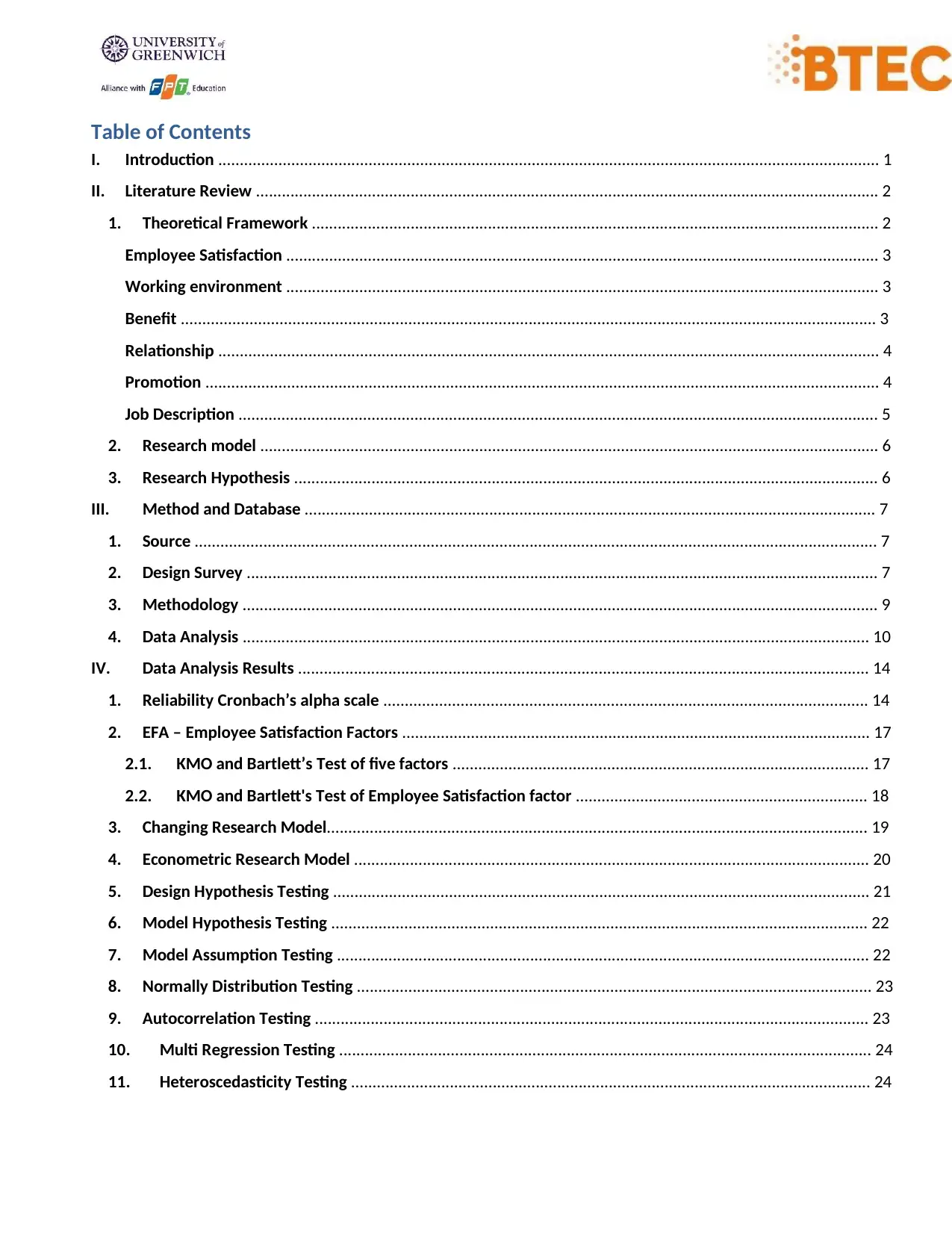
Table of Contents
I. Introduction .......................................................................................................................................................... 1
II. Literature Review ................................................................................................................................................. 2
1. Theoretical Framework .................................................................................................................................... 2
Employee Satisfaction .......................................................................................................................................... 3
Working environment .......................................................................................................................................... 3
Benefit .................................................................................................................................................................. 3
Relationship .......................................................................................................................................................... 4
Promotion ............................................................................................................................................................. 4
Job Description ..................................................................................................................................................... 5
2. Research model ................................................................................................................................................ 6
3. Research Hypothesis ........................................................................................................................................ 6
III. Method and Database ..................................................................................................................................... 7
1. Source ............................................................................................................................................................... 7
2. Design Survey ................................................................................................................................................... 7
3. Methodology .................................................................................................................................................... 9
4. Data Analysis .................................................................................................................................................. 10
IV. Data Analysis Results ..................................................................................................................................... 14
1. Reliability Cronbach’s alpha scale ................................................................................................................. 14
2. EFA – Employee Satisfaction Factors ............................................................................................................. 17
2.1. KMO and Bartlett’s Test of five factors ................................................................................................. 17
2.2. KMO and Bartlett's Test of Employee Satisfaction factor .................................................................... 18
3. Changing Research Model.............................................................................................................................. 19
4. Econometric Research Model ........................................................................................................................ 20
5. Design Hypothesis Testing ............................................................................................................................. 21
6. Model Hypothesis Testing ............................................................................................................................. 22
7. Model Assumption Testing ............................................................................................................................ 22
8. Normally Distribution Testing ........................................................................................................................ 23
9. Autocorrelation Testing ................................................................................................................................. 23
10. Multi Regression Testing ............................................................................................................................ 24
11. Heteroscedasticity Testing ......................................................................................................................... 24
I. Introduction .......................................................................................................................................................... 1
II. Literature Review ................................................................................................................................................. 2
1. Theoretical Framework .................................................................................................................................... 2
Employee Satisfaction .......................................................................................................................................... 3
Working environment .......................................................................................................................................... 3
Benefit .................................................................................................................................................................. 3
Relationship .......................................................................................................................................................... 4
Promotion ............................................................................................................................................................. 4
Job Description ..................................................................................................................................................... 5
2. Research model ................................................................................................................................................ 6
3. Research Hypothesis ........................................................................................................................................ 6
III. Method and Database ..................................................................................................................................... 7
1. Source ............................................................................................................................................................... 7
2. Design Survey ................................................................................................................................................... 7
3. Methodology .................................................................................................................................................... 9
4. Data Analysis .................................................................................................................................................. 10
IV. Data Analysis Results ..................................................................................................................................... 14
1. Reliability Cronbach’s alpha scale ................................................................................................................. 14
2. EFA – Employee Satisfaction Factors ............................................................................................................. 17
2.1. KMO and Bartlett’s Test of five factors ................................................................................................. 17
2.2. KMO and Bartlett's Test of Employee Satisfaction factor .................................................................... 18
3. Changing Research Model.............................................................................................................................. 19
4. Econometric Research Model ........................................................................................................................ 20
5. Design Hypothesis Testing ............................................................................................................................. 21
6. Model Hypothesis Testing ............................................................................................................................. 22
7. Model Assumption Testing ............................................................................................................................ 22
8. Normally Distribution Testing ........................................................................................................................ 23
9. Autocorrelation Testing ................................................................................................................................. 23
10. Multi Regression Testing ............................................................................................................................ 24
11. Heteroscedasticity Testing ......................................................................................................................... 24
Paraphrase This Document
Need a fresh take? Get an instant paraphrase of this document with our AI Paraphraser
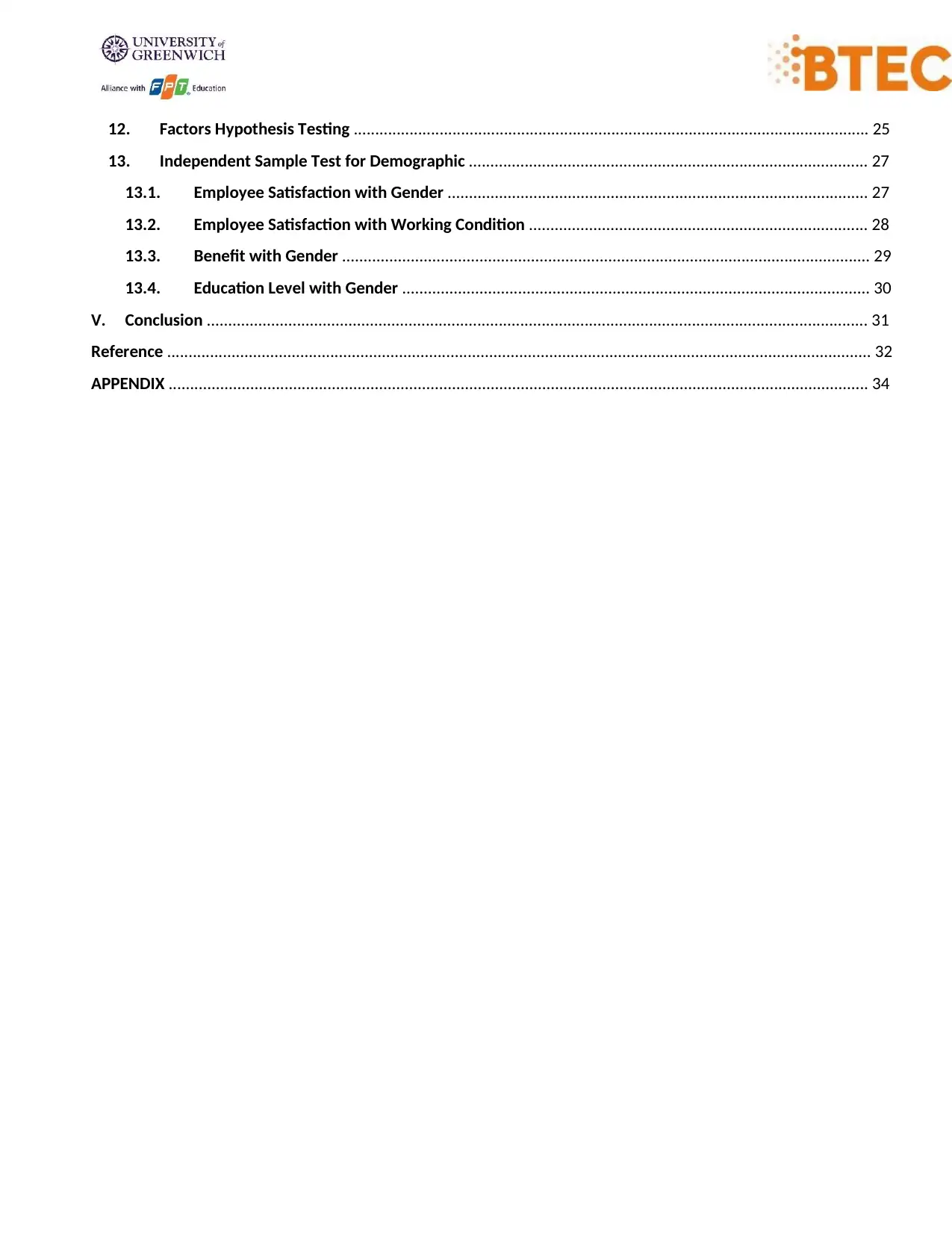
12. Factors Hypothesis Testing ........................................................................................................................ 25
13. Independent Sample Test for Demographic ............................................................................................. 27
13.1. Employee Satisfaction with Gender .................................................................................................. 27
13.2. Employee Satisfaction with Working Condition ............................................................................... 28
13.3. Benefit with Gender ........................................................................................................................... 29
13.4. Education Level with Gender ............................................................................................................. 30
V. Conclusion .......................................................................................................................................................... 31
Reference .................................................................................................................................................................... 32
APPENDIX ................................................................................................................................................................... 34
13. Independent Sample Test for Demographic ............................................................................................. 27
13.1. Employee Satisfaction with Gender .................................................................................................. 27
13.2. Employee Satisfaction with Working Condition ............................................................................... 28
13.3. Benefit with Gender ........................................................................................................................... 29
13.4. Education Level with Gender ............................................................................................................. 30
V. Conclusion .......................................................................................................................................................... 31
Reference .................................................................................................................................................................... 32
APPENDIX ................................................................................................................................................................... 34
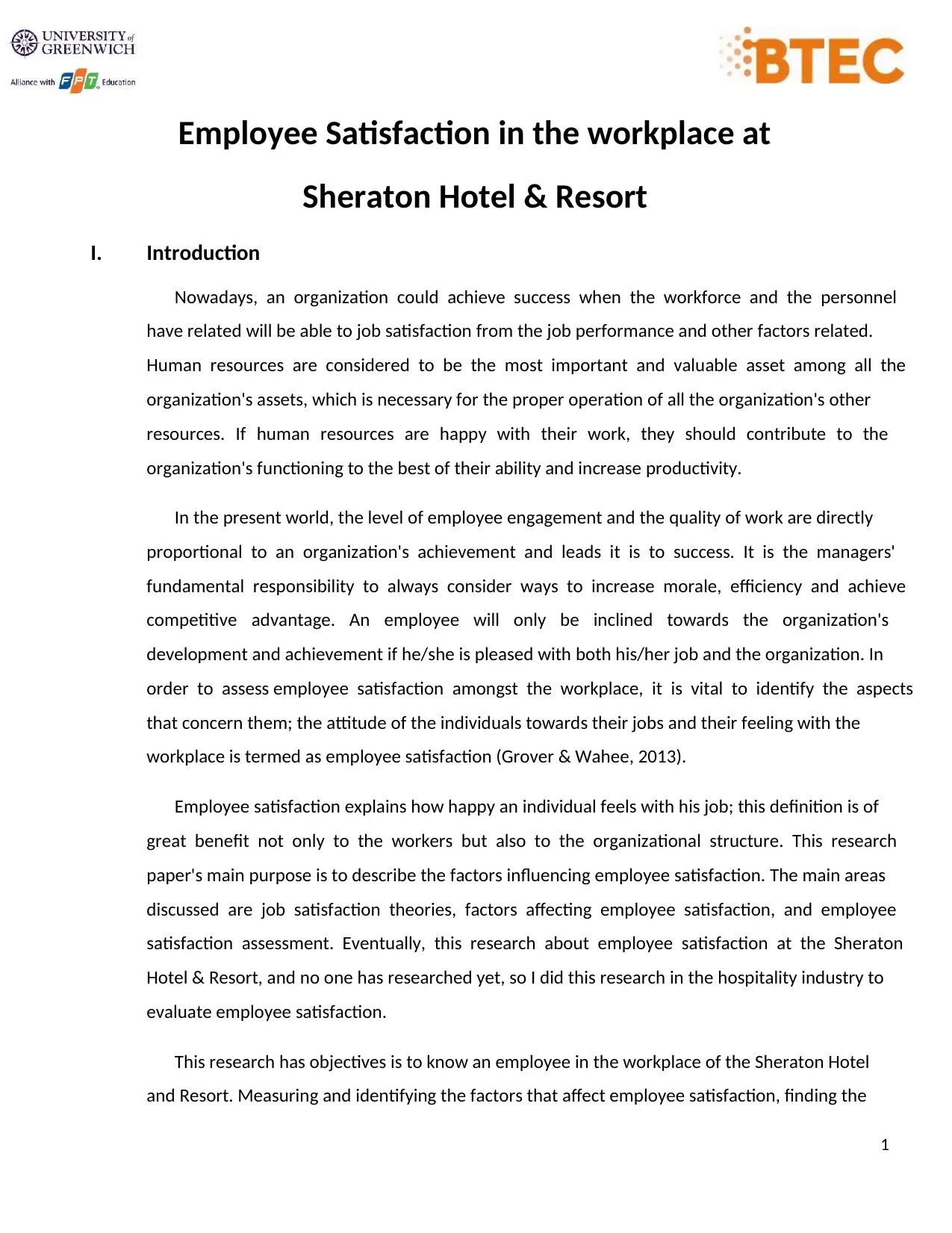
1
Employee Satisfaction in the workplace at
Sheraton Hotel & Resort
I. Introduction
Nowadays, an organization could achieve success when the workforce and the personnel
have related will be able to job satisfaction from the job performance and other factors related.
Human resources are considered to be the most important and valuable asset among all the
organization's assets, which is necessary for the proper operation of all the organization's other
resources. If human resources are happy with their work, they should contribute to the
organization's functioning to the best of their ability and increase productivity.
In the present world, the level of employee engagement and the quality of work are directly
proportional to an organization's achievement and leads it is to success. It is the managers'
fundamental responsibility to always consider ways to increase morale, efficiency and achieve
competitive advantage. An employee will only be inclined towards the organization's
development and achievement if he/she is pleased with both his/her job and the organization. In
order to assess employee satisfaction amongst the workplace, it is vital to identify the aspects
that concern them; the attitude of the individuals towards their jobs and their feeling with the
workplace is termed as employee satisfaction (Grover & Wahee, 2013).
Employee satisfaction explains how happy an individual feels with his job; this definition is of
great benefit not only to the workers but also to the organizational structure. This research
paper's main purpose is to describe the factors influencing employee satisfaction. The main areas
discussed are job satisfaction theories, factors affecting employee satisfaction, and employee
satisfaction assessment. Eventually, this research about employee satisfaction at the Sheraton
Hotel & Resort, and no one has researched yet, so I did this research in the hospitality industry to
evaluate employee satisfaction.
This research has objectives is to know an employee in the workplace of the Sheraton Hotel
and Resort. Measuring and identifying the factors that affect employee satisfaction, finding the
Employee Satisfaction in the workplace at
Sheraton Hotel & Resort
I. Introduction
Nowadays, an organization could achieve success when the workforce and the personnel
have related will be able to job satisfaction from the job performance and other factors related.
Human resources are considered to be the most important and valuable asset among all the
organization's assets, which is necessary for the proper operation of all the organization's other
resources. If human resources are happy with their work, they should contribute to the
organization's functioning to the best of their ability and increase productivity.
In the present world, the level of employee engagement and the quality of work are directly
proportional to an organization's achievement and leads it is to success. It is the managers'
fundamental responsibility to always consider ways to increase morale, efficiency and achieve
competitive advantage. An employee will only be inclined towards the organization's
development and achievement if he/she is pleased with both his/her job and the organization. In
order to assess employee satisfaction amongst the workplace, it is vital to identify the aspects
that concern them; the attitude of the individuals towards their jobs and their feeling with the
workplace is termed as employee satisfaction (Grover & Wahee, 2013).
Employee satisfaction explains how happy an individual feels with his job; this definition is of
great benefit not only to the workers but also to the organizational structure. This research
paper's main purpose is to describe the factors influencing employee satisfaction. The main areas
discussed are job satisfaction theories, factors affecting employee satisfaction, and employee
satisfaction assessment. Eventually, this research about employee satisfaction at the Sheraton
Hotel & Resort, and no one has researched yet, so I did this research in the hospitality industry to
evaluate employee satisfaction.
This research has objectives is to know an employee in the workplace of the Sheraton Hotel
and Resort. Measuring and identifying the factors that affect employee satisfaction, finding the
⊘ This is a preview!⊘
Do you want full access?
Subscribe today to unlock all pages.

Trusted by 1+ million students worldwide
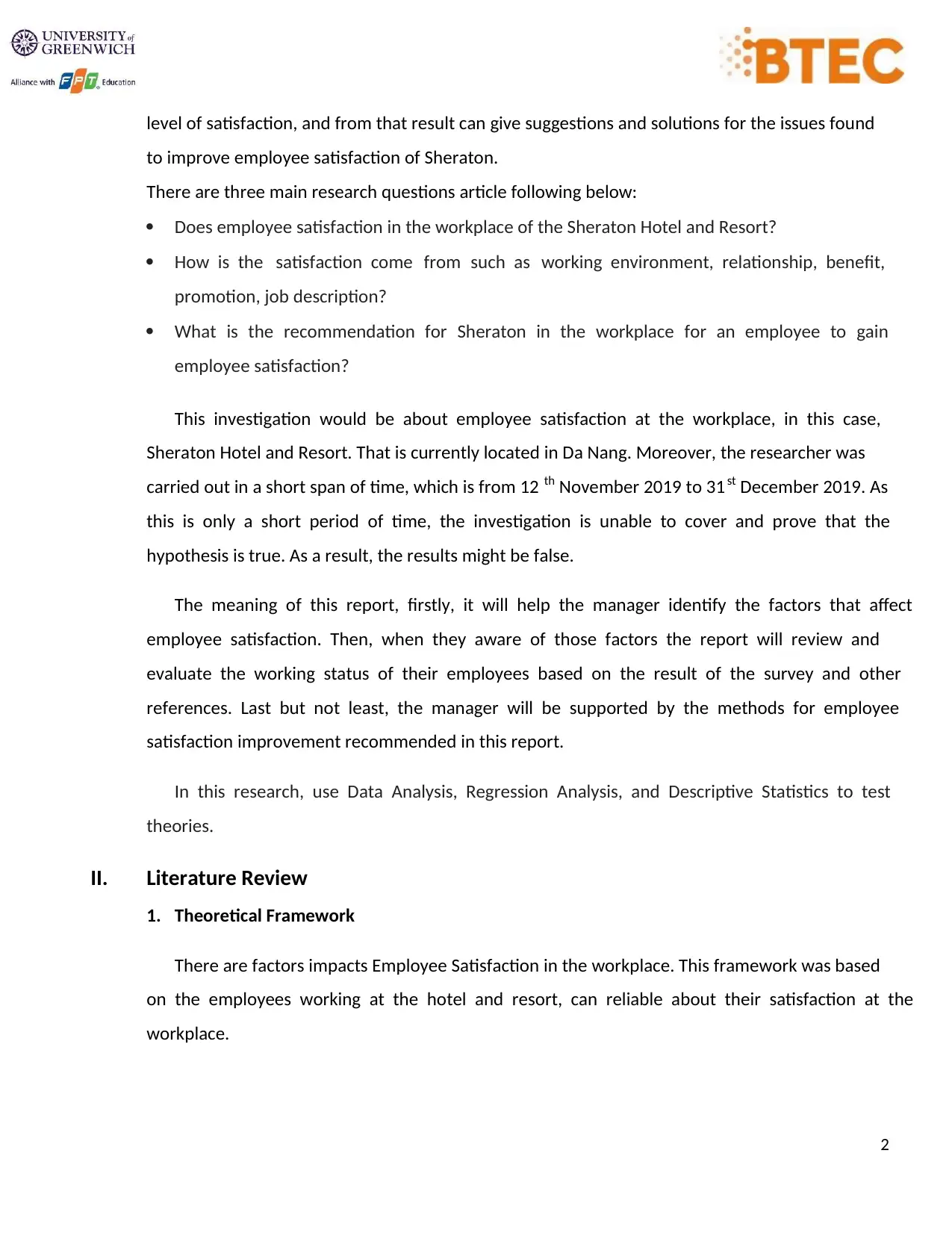
2
level of satisfaction, and from that result can give suggestions and solutions for the issues found
to improve employee satisfaction of Sheraton.
There are three main research questions article following below:
Does employee satisfaction in the workplace of the Sheraton Hotel and Resort?
How is the satisfaction come from such as working environment, relationship, benefit,
promotion, job description?
What is the recommendation for Sheraton in the workplace for an employee to gain
employee satisfaction?
This investigation would be about employee satisfaction at the workplace, in this case,
Sheraton Hotel and Resort. That is currently located in Da Nang. Moreover, the researcher was
carried out in a short span of time, which is from 12 th November 2019 to 31st December 2019. As
this is only a short period of time, the investigation is unable to cover and prove that the
hypothesis is true. As a result, the results might be false.
The meaning of this report, firstly, it will help the manager identify the factors that affect
employee satisfaction. Then, when they aware of those factors the report will review and
evaluate the working status of their employees based on the result of the survey and other
references. Last but not least, the manager will be supported by the methods for employee
satisfaction improvement recommended in this report.
In this research, use Data Analysis, Regression Analysis, and Descriptive Statistics to test
theories.
II. Literature Review
1. Theoretical Framework
There are factors impacts Employee Satisfaction in the workplace. This framework was based
on the employees working at the hotel and resort, can reliable about their satisfaction at the
workplace.
level of satisfaction, and from that result can give suggestions and solutions for the issues found
to improve employee satisfaction of Sheraton.
There are three main research questions article following below:
Does employee satisfaction in the workplace of the Sheraton Hotel and Resort?
How is the satisfaction come from such as working environment, relationship, benefit,
promotion, job description?
What is the recommendation for Sheraton in the workplace for an employee to gain
employee satisfaction?
This investigation would be about employee satisfaction at the workplace, in this case,
Sheraton Hotel and Resort. That is currently located in Da Nang. Moreover, the researcher was
carried out in a short span of time, which is from 12 th November 2019 to 31st December 2019. As
this is only a short period of time, the investigation is unable to cover and prove that the
hypothesis is true. As a result, the results might be false.
The meaning of this report, firstly, it will help the manager identify the factors that affect
employee satisfaction. Then, when they aware of those factors the report will review and
evaluate the working status of their employees based on the result of the survey and other
references. Last but not least, the manager will be supported by the methods for employee
satisfaction improvement recommended in this report.
In this research, use Data Analysis, Regression Analysis, and Descriptive Statistics to test
theories.
II. Literature Review
1. Theoretical Framework
There are factors impacts Employee Satisfaction in the workplace. This framework was based
on the employees working at the hotel and resort, can reliable about their satisfaction at the
workplace.
Paraphrase This Document
Need a fresh take? Get an instant paraphrase of this document with our AI Paraphraser
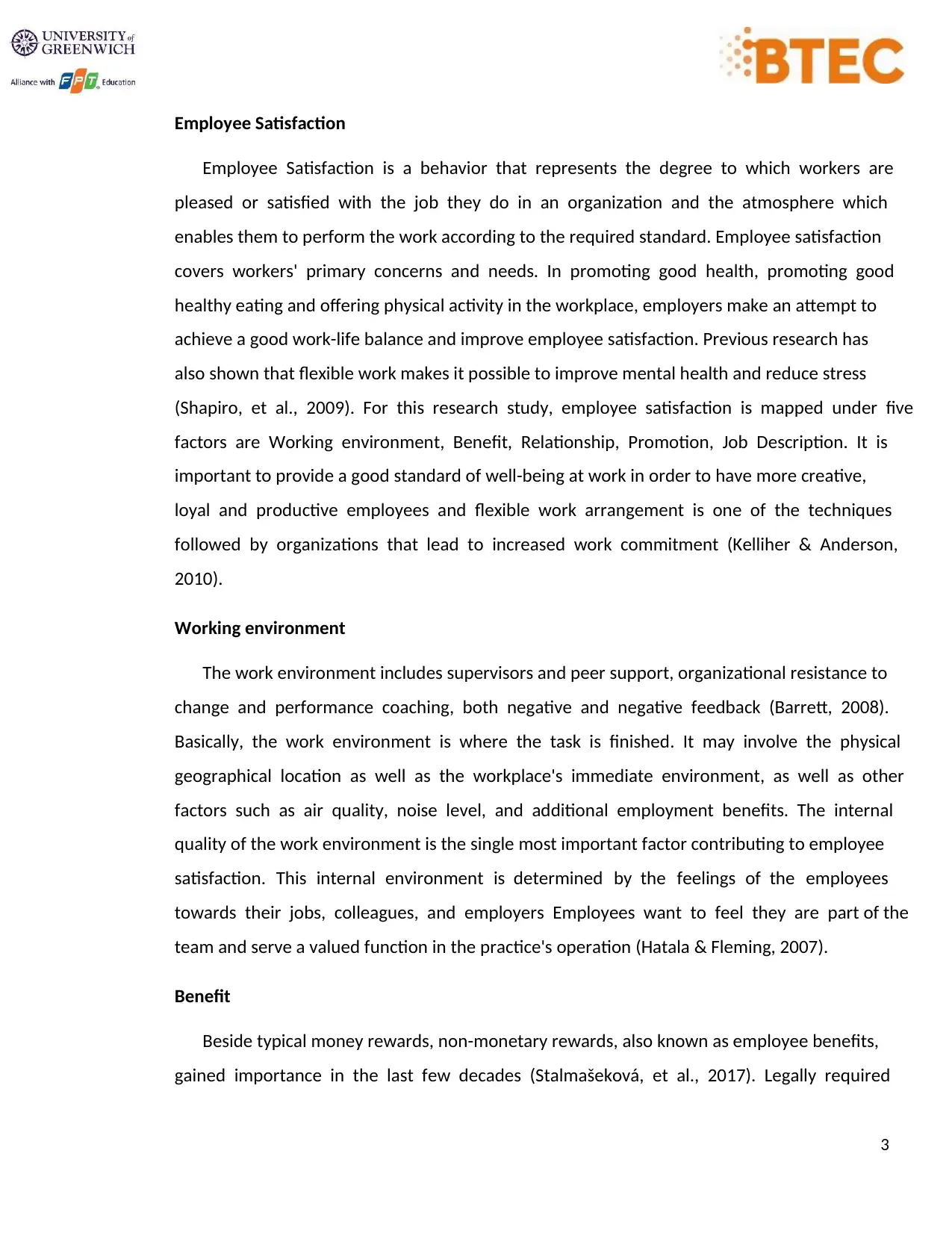
3
Employee Satisfaction
Employee Satisfaction is a behavior that represents the degree to which workers are
pleased or satisfied with the job they do in an organization and the atmosphere which
enables them to perform the work according to the required standard. Employee satisfaction
covers workers' primary concerns and needs. In promoting good health, promoting good
healthy eating and offering physical activity in the workplace, employers make an attempt to
achieve a good work-life balance and improve employee satisfaction. Previous research has
also shown that flexible work makes it possible to improve mental health and reduce stress
(Shapiro, et al., 2009). For this research study, employee satisfaction is mapped under five
factors are Working environment, Benefit, Relationship, Promotion, Job Description. It is
important to provide a good standard of well-being at work in order to have more creative,
loyal and productive employees and flexible work arrangement is one of the techniques
followed by organizations that lead to increased work commitment (Kelliher & Anderson,
2010).
Working environment
The work environment includes supervisors and peer support, organizational resistance to
change and performance coaching, both negative and negative feedback (Barrett, 2008).
Basically, the work environment is where the task is finished. It may involve the physical
geographical location as well as the workplace's immediate environment, as well as other
factors such as air quality, noise level, and additional employment benefits. The internal
quality of the work environment is the single most important factor contributing to employee
satisfaction. This internal environment is determined by the feelings of the employees
towards their jobs, colleagues, and employers Employees want to feel they are part of the
team and serve a valued function in the practice's operation (Hatala & Fleming, 2007).
Benefit
Beside typical money rewards, non-monetary rewards, also known as employee benefits,
gained importance in the last few decades (Stalmašeková, et al., 2017). Legally required
Employee Satisfaction
Employee Satisfaction is a behavior that represents the degree to which workers are
pleased or satisfied with the job they do in an organization and the atmosphere which
enables them to perform the work according to the required standard. Employee satisfaction
covers workers' primary concerns and needs. In promoting good health, promoting good
healthy eating and offering physical activity in the workplace, employers make an attempt to
achieve a good work-life balance and improve employee satisfaction. Previous research has
also shown that flexible work makes it possible to improve mental health and reduce stress
(Shapiro, et al., 2009). For this research study, employee satisfaction is mapped under five
factors are Working environment, Benefit, Relationship, Promotion, Job Description. It is
important to provide a good standard of well-being at work in order to have more creative,
loyal and productive employees and flexible work arrangement is one of the techniques
followed by organizations that lead to increased work commitment (Kelliher & Anderson,
2010).
Working environment
The work environment includes supervisors and peer support, organizational resistance to
change and performance coaching, both negative and negative feedback (Barrett, 2008).
Basically, the work environment is where the task is finished. It may involve the physical
geographical location as well as the workplace's immediate environment, as well as other
factors such as air quality, noise level, and additional employment benefits. The internal
quality of the work environment is the single most important factor contributing to employee
satisfaction. This internal environment is determined by the feelings of the employees
towards their jobs, colleagues, and employers Employees want to feel they are part of the
team and serve a valued function in the practice's operation (Hatala & Fleming, 2007).
Benefit
Beside typical money rewards, non-monetary rewards, also known as employee benefits,
gained importance in the last few decades (Stalmašeková, et al., 2017). Legally required
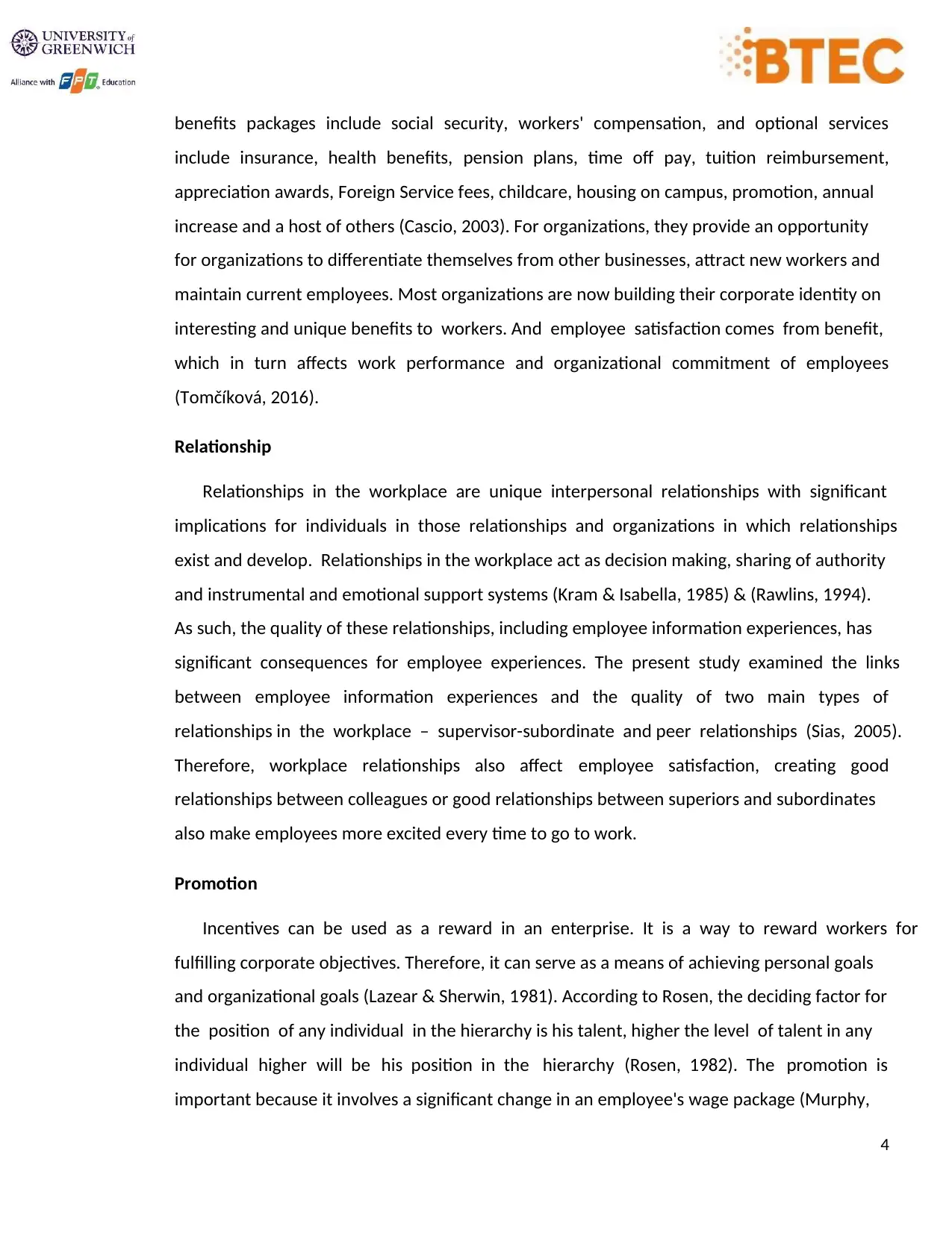
4
benefits packages include social security, workers' compensation, and optional services
include insurance, health benefits, pension plans, time off pay, tuition reimbursement,
appreciation awards, Foreign Service fees, childcare, housing on campus, promotion, annual
increase and a host of others (Cascio, 2003). For organizations, they provide an opportunity
for organizations to differentiate themselves from other businesses, attract new workers and
maintain current employees. Most organizations are now building their corporate identity on
interesting and unique benefits to workers. And employee satisfaction comes from benefit,
which in turn affects work performance and organizational commitment of employees
(Tomčíková, 2016).
Relationship
Relationships in the workplace are unique interpersonal relationships with significant
implications for individuals in those relationships and organizations in which relationships
exist and develop. Relationships in the workplace act as decision making, sharing of authority
and instrumental and emotional support systems (Kram & Isabella, 1985) & (Rawlins, 1994).
As such, the quality of these relationships, including employee information experiences, has
significant consequences for employee experiences. The present study examined the links
between employee information experiences and the quality of two main types of
relationships in the workplace – supervisor-subordinate and peer relationships (Sias, 2005).
Therefore, workplace relationships also affect employee satisfaction, creating good
relationships between colleagues or good relationships between superiors and subordinates
also make employees more excited every time to go to work.
Promotion
Incentives can be used as a reward in an enterprise. It is a way to reward workers for
fulfilling corporate objectives. Therefore, it can serve as a means of achieving personal goals
and organizational goals (Lazear & Sherwin, 1981). According to Rosen, the deciding factor for
the position of any individual in the hierarchy is his talent, higher the level of talent in any
individual higher will be his position in the hierarchy (Rosen, 1982). The promotion is
important because it involves a significant change in an employee's wage package (Murphy,
benefits packages include social security, workers' compensation, and optional services
include insurance, health benefits, pension plans, time off pay, tuition reimbursement,
appreciation awards, Foreign Service fees, childcare, housing on campus, promotion, annual
increase and a host of others (Cascio, 2003). For organizations, they provide an opportunity
for organizations to differentiate themselves from other businesses, attract new workers and
maintain current employees. Most organizations are now building their corporate identity on
interesting and unique benefits to workers. And employee satisfaction comes from benefit,
which in turn affects work performance and organizational commitment of employees
(Tomčíková, 2016).
Relationship
Relationships in the workplace are unique interpersonal relationships with significant
implications for individuals in those relationships and organizations in which relationships
exist and develop. Relationships in the workplace act as decision making, sharing of authority
and instrumental and emotional support systems (Kram & Isabella, 1985) & (Rawlins, 1994).
As such, the quality of these relationships, including employee information experiences, has
significant consequences for employee experiences. The present study examined the links
between employee information experiences and the quality of two main types of
relationships in the workplace – supervisor-subordinate and peer relationships (Sias, 2005).
Therefore, workplace relationships also affect employee satisfaction, creating good
relationships between colleagues or good relationships between superiors and subordinates
also make employees more excited every time to go to work.
Promotion
Incentives can be used as a reward in an enterprise. It is a way to reward workers for
fulfilling corporate objectives. Therefore, it can serve as a means of achieving personal goals
and organizational goals (Lazear & Sherwin, 1981). According to Rosen, the deciding factor for
the position of any individual in the hierarchy is his talent, higher the level of talent in any
individual higher will be his position in the hierarchy (Rosen, 1982). The promotion is
important because it involves a significant change in an employee's wage package (Murphy,
⊘ This is a preview!⊘
Do you want full access?
Subscribe today to unlock all pages.

Trusted by 1+ million students worldwide
1 out of 46
Related Documents
Your All-in-One AI-Powered Toolkit for Academic Success.
+13062052269
info@desklib.com
Available 24*7 on WhatsApp / Email
![[object Object]](/_next/static/media/star-bottom.7253800d.svg)
Unlock your academic potential
Copyright © 2020–2025 A2Z Services. All Rights Reserved. Developed and managed by ZUCOL.





